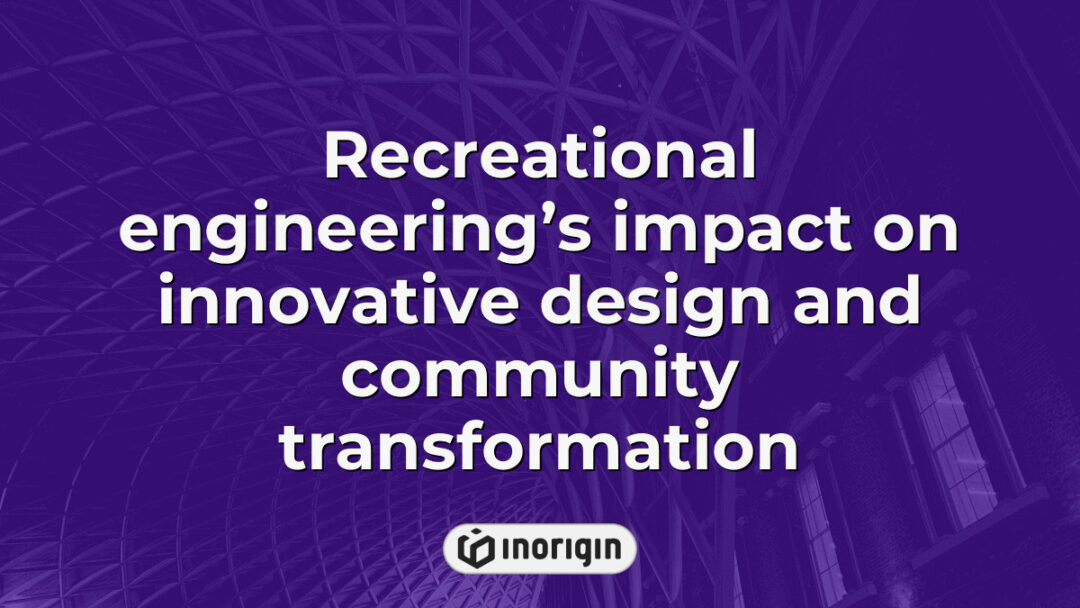In a world where creativity and technology converge, the captivating concept of recreational engineering emerges as a dynamic discipline that defies traditional boundaries. This innovative field encompasses the artful application of engineering principles to craft engaging, enjoyable experiences through play and leisure. By harnessing human ingenuity, recreational engineering transforms everyday environments into exhilarating escapades, fostering an atmosphere of exploration and enjoyment. As society increasingly values recreation as a vital component of well-being, the significance of this multifaceted discipline grows, challenging engineers to design not merely functional structures, but also vibrant, interactive spaces that inspire joy and collaboration.
| Aspect | Key Takeaway |
|---|---|
| Definition | Recreational engineering applies engineering principles to design engaging and interactive leisure experiences that enhance user enjoyment and foster community well-being. |
| Evolution and Scope | This field has evolved from simple parks to multifunctional facilities integrating urban design, social health, and environmental sustainability. |
| Facility Diversity | It encompasses various spaces including sports complexes, adventure parks, community centers, and inclusive public areas that support active lifestyles. |
| Safety and Maintenance | Regular safety and maintenance surveys are essential for hazard identification, extending asset lifecycles, and ensuring secure recreational environments. |
| Innovative Integration | Modern projects leverage sustainable materials and smart technologies like sensor-equipped fitness stations to enhance adaptability and eco-consciousness. |
| Environmental Role | Recreational engineering promotes biodiversity and resource conservation while encouraging public engagement with nature through thoughtful design. |
| Career Pathways | Careers include facility management, landscape architecture, and experiential design, emphasizing innovative, safe, and community-centered solutions. |
Exploring the Origins and Evolution of Recreational Engineering
Recreational engineering has undergone significant transformations, with its roots tracing back to the early 20th century when urban planners and landscape architects began to recognize the necessity of integrating recreational spaces into urban design. The initial efforts primarily focused on creating parks to serve growing populations, highlighting the emerging field’s connection to public health and social well-being. As time progressed, the scope of recreation engineering expanded markedly, from simple playgrounds to complex recreational facilities that include sports complexes, nature trails, and adventure parks. Consequently, the discipline not only encompasses the physical design of these spaces but also involves community engagement, environmental sustainability and economic viability, prompting a multi-disciplinary approach that blends art and science. The influence of this field on urban environments has evolved, reflecting changing societal values—particularly the importance of accessible recreational options for fostering community interaction and enhancing quality of life. Hence, recreational engineering, through the lens of designing parks and other recreational facilities, encapsulates a rich history that continues to evolve, urging stakeholders to consider a collaborative method in future developments while ensuring these spaces serve diverse community needs effectively.
Diverse Fields and Activities Involving Recreational Engineering
The examination of diverse fields and activities involving recreational engineering highlights the multifaceted nature of this discipline. Within this scope, various facilities emerge, each serving distinct functions while supporting different activities. First, sports complexes bring together facilities for football, basketball, and swimming, fostering community engagement through organised events; second, adventure parks offer experiences such as rock climbing and zip-lining, appealing to thrill-seekers of all ages. Third, community centres facilitate workshops on crafting and DIY projects, which serve to educate individuals in practical skills. Fourth, public parks provide inclusive spaces for picnics, games, or leisurely walks, contributing to physical well-being. Lastly, art installations within urban areas prompt opportunities for recreational interaction, blending culture with leisure. Each facility not only caters to specific activities but also serves to enhance social interaction and promote healthy lifestyles, fostering a sense of community and belonging. The significance of such diverse fields in recreational engineering cannot be overstated; the implications extend into community building, addressing modern lifestyles and the importance of physical activity in day-to-day life.
Essential Skills and Tools for Recreational Engineers
In the context of recreational engineering, the role of safety and maintenance surveys is underscored by the striking fact that approximately 42% of reported accidents in recreational facilities stem from inadequate safety protocols. This statistic not only highlights the critical need for rigorous safety surveys but also establishes a firm basis for systematic maintenance surveys to ensure ongoing compliance and usability of recreational spaces. These surveys serve as integral tools for recreational engineers; they facilitate the identification of potential hazards, assess the condition of equipment, and verify the safety of installations. For instance, conducting a proper maintenance survey not only mitigates risks but also extends the operational life of recreational assets, which can involve varied environments ranging from parks to water-based recreation areas. Thus, the implementation of such assessments is not merely a regulatory obligation but an ethical responsibility aimed at ensuring participant safety and enhancing the overall recreational experience. The data and insights gained through these surveys are invaluable and serve to inform decision-making processes regarding necessary renovations or improvements, fundamentally shaping the landscape of recreational engineering.
Innovative Projects and Ideas in Recreational Engineering
Recreational engineering embodies a fascinating intersection of creativity and functionality, reminiscent of historic parks designed by figures like Frederick Law Olmsted, who transformed landscapes and public spaces. In contemporary practice, the innovation in recreational projects emerges from a synergy of design elements that not only enhance user experience but also foster community connections. Facilities enhancement becomes the crux of these undertakings, where the integration of sustainable materials and advanced technology plays a crucial role, often influencing the overall environmental footprint of such projects. The incorporation of multi-functional spaces, adaptable playgrounds, and inclusive recreational areas illustrates the evolving paradigm within this field, addressing diverse user needs and preferences. For instance, the implementation of smart technology in parks, such as fitness stations equipped with sensors for performance tracking, represents a novel approach that enhances user engagement while promoting healthy lifestyles. Looking to the future, the continued adaptation and incorporation of innovative ideas within recreational engineering will likely forge pathways for transformative community spaces that resonate with broad audiences while simultaneously prioritising ecological sustainability.
Impact of Recreational Engineering on Society and Culture
The impact of recreational engineering on society and culture is akin to the ripples created by a stone thrown into a still pond, expanding outward to touch various aspects of community life. This field—rooted in the principles of design and utilisation of recreational spaces—has shown significant contributions to community well-being and active living. As societies become increasingly urbanised and the demands of modern life intensify, the need for thoughtfully designed recreational environments emerges as a critical factor in enhancing quality of life. Specifically, the influence can be examined through three fundamental areas:
- The promotion of physical health through accessible outdoor spaces that encourage exercise and leisure activities.
- The strengthening of community bonds by providing venues for social interaction and events.
- The fostering of environmental stewardship by integrating green design principles into recreational projects.
Given these elements, recreational engineering serves not merely as an avenue for fun but as a strategic effort to cultivate healthier, more engaged populations. By facilitating active living, these initiatives also align with broader public health objectives, which recognise the connection between physical activity, mental health, and community vitality. The increasing recognition of this interdependence suggests that recreational engineering does not exist in isolation; rather, it forms a critical part of societal infrastructures aimed at enhancing the human experience. Ultimately, this synergy between engineering practices and community health imperatives underscore its importance in crafting spaces that nurture both individual well-being and collective cultural identity.
Frequently Asked Questions
What career opportunities are available in recreational engineering?
The field of recreational engineering presents a fascinating array of career opportunities that straddle the intersection of design, technology, and leisure. As the demand for innovative recreational spaces increases, professionals in this domain find themselves involved in the conceptualisation and development of parks, playgrounds, sports facilities, and immersive entertainment environments. In particular, roles such as recreation facility manager, landscape architect, and experiential designer have gained prominence. For instance, the National Recreation and Park Association (NRPA) claims there are over 100,000 parks across the USA, each requiring skilled engineers to optimise their layout and functionality. Likewise, amusement park engineers focus on ensuring safety while enhancing user experience, reflecting a dual commitment to creativity and responsibility. Consequently, the sector not only nurtures recreational spaces but also prioritises sustainability through eco-friendly designs that comply with regulations and community needs. Ultimately, career pathways in recreational engineering are characterised by an evolving approach to leisure and wellbeing, illuminating the significance of such spaces in modern life while fostering a harmonious balance between enjoyment and engineering ethics, which becomes increasingly essential in today’s society.
How does recreational engineering influence environmental sustainability?
Recreational engineering plays a significant role in shaping practices around environmental sustainability, intertwining the development of leisure facilities with ecological consideration. Firstly, the design of parks and recreational spaces often incorporates natural elements, thereby mitigating urban heat islands and promoting biodiversity; for example, projects like the High Line in New York City effectively transformed an unused rail line into an ecological corridor. In addition, many recreational engineers are now integrating sustainable materials and energy-efficient technologies into their designs. This includes using recycled materials for playgrounds or ensuring that water features are equipped with systems that recycle water; such innovations contribute to the reduction of resource depletion. Not to be overlooked, the promotion of outdoor activities encourages a connection to nature, potentially fostering greater public awareness regarding conservation issues. Hence, the connection between recreational engineering and environmental sustainability is both practical and profound, illustrating the necessity for outdoor spaces that serve not just users, but also the environment. The implications of these efforts will likely resonate well into the future as communities increasingly prioritize sustainable practises in leisure activities.
What are some famous landmarks or infrastructures designed using principles of recreational engineering?
The world is adorned with astonishing engineering marvels that captivate the imagination, each standing as a magnificent testament to human ingenuity. When considering recreational engineering, the influence on landmarks and infrastructures becomes palpably significant. These extraordinary creations not only serve recreational purposes but also embody sustainability principles that harmonise human activity with the environment. Some of the most famous examples include the High Line in New York City, the Eden Project in Cornwall, and the iconic Millennium Park in Chicago. Each of these infrastructures demonstrates a profound commitment to blending natural elements with urban environments while providing spaces that foster social interaction and ecological awareness.
- The High Line, a former railway turned elevated park, showcases sustainable practices by incorporating native plants that require less water and maintenance.
- The Eden Project features biomes housing diverse ecosystems, educating the public on biodiversity and the importance of conservation.
- Millennium Park includes green roofs and integrated rainfall management systems, illustrating innovative approaches to urban green spaces.
The importance of these structures extends beyond mere aesthetics; they actively contribute to environmental awareness and community engagement. The High Line has transformed a neglected urban area into a lush public space, enhancing local ecosystems and promoting biodiversity. The Eden Project, inaugurated in 2001, serves as a global leader in environmental education, attracting over a million visitors annually to witness sustainable practices in action. Millennium Park, meanwhile, harnesses cutting-edge design to create a multifunctional public space that sweeps visitors into a realm of art, ecology, and recreation. These landmarks, among others, exemplify how recreational engineering can yield a profound impact on both community and environment, illustrating a future where engineering and sustainability harmoniously coexist.
Conclusion
In conclusion, recreational engineering serves as a vibrant tapestry of creativity and innovation, inviting individuals to weave their own narratives through exploration and design. By fostering an environment where imagination thrives, this discipline transforms mundane materials into extraordinary creations, demonstrating that the simplest tools can unlock boundless possibilities in human expression.
Related posts:
- Revolutionizing Mobility and Innovation in the Recreation Vehicle Industry
- St. Louis County Real Estate Trends Shaping Investment and Homebuyer Choices in 2024
- St louis county real estate information on market trends, neighborhoods, and future outlook
- Arrowhead Engineered Products Locations Showcasing Strategic Manufacturing Hubs and Global Distribution Networks
- Legal Frameworks and Ethical Debates Surrounding 3D Printed Weapons in Modern Society
- St louis real estate Market Dynamics Shaping Neighborhood Growth and Home Values




